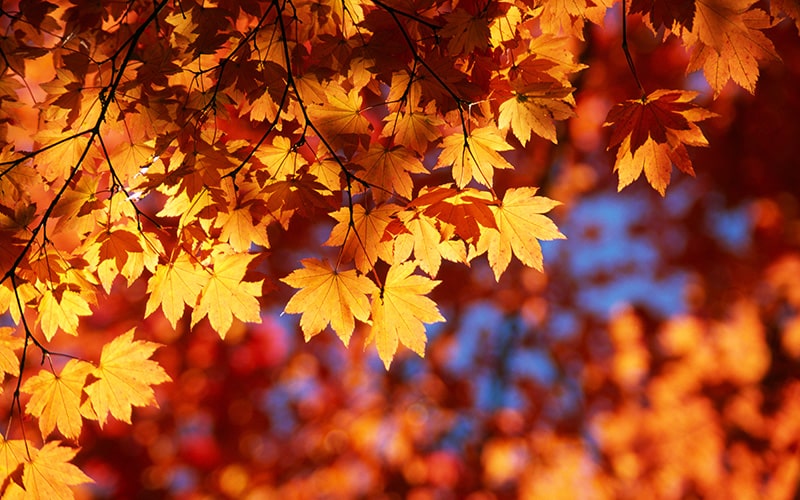Cooling temperatures and shorter days mean it’s time to deal with falling leaves that cover the lawn.
Thanks to the focus on sustainability, we know there are better options than blowing leaves into plastic bags to have hauled to the landfill. Gardening experts and entities that collect waste recommend alternatives for fall leaf disposal that keep leaves out of the waste stream and are better for the environment.
Problems with landfilling autumn leaves
Grass clippings, pruned branches, fallen leaves and other yard waste has been the third-largest component of municipal solid waste by weight, according to the website Waste 360. Of this yard waste, fallen leaves add the most by volume. Putting leaves in plastic trash bags and putting them at the curb for garbage pick up sends them to the local landfill, where they take up a significant amount of landfill space. Not putting yard waste out with the trash can help divert a huge volume of waste from filling up landfills around the country. Additionally, as organic matter like yard waste and green material decomposes in the presence of non-organic materials in landfills, methane is released in large quantities. Methane emissions trap heat in the atmosphere and contribute to climate change.
Finally, sending leaves to the landfill is like throwing money out the window. This is because leaves can easily be composted into a nutrient-rich organic fertilizer that can be used on lawns and gardens. Composting leaves has many benefits, such as reducing the amount of money spent on chemical fertilizers, reducing the water needs of your lawn, and increasing your lawn’s resiliency against weeds and pests.
Better options for fall leaves and yard waste
1. Municipal Composting:
One simple option is to dispose of leaves through municipal composting. Most communities now offer curbside collection of leaves and yard waste or allow residents to bring leaves to a central location. Leaves are then composted at these facilities and the compost made available to the public. Your local trash and recycling collector will have this information on their website.
2. Home composting:
Putting yard waste out for municipal compost collection is better than putting leaves into trash collection. Composting your leaves at home, however, reduces the amount of yard trimming that must be collected, transported, and processed. For this reason, a growing number of counties now provide compost bins to residents at no additional cost. Once assembled at your own home, yard trim, leaves and grass clippings can be added to the compost bin.
Leaves dumped alone in a compost bin or pile will decompose slowly. Mixing the leaves with grass clippings or composted manure or fertilizer will change them into organic matter for a garden by the spring. Composting experts recommend keeping the materials moist and mixing them every other week. The leaves will also decompose faster if they are shredded first. To shred the leaves, rake them into low piles and mow over them a few times. Another easy way to do this is to use the lawnmower bagging attachment, mow over the leaves, and then empty the bag into your compost pile.
Vegetable and flower garden mulch tips:
- Spread shredded leaves around the bases of young trees or shrubs.
- Use shredded leaves to cover bare soil in your vegetable garden during cold weather months. This will help protect vegetables like carrots, kale, leeks, and beets for extended harvest. In the spring, turn the leaves into the soil.
- Shredded leaves make good mulch for flower garden beds. The leaves will gradually turn into compost, enriching the soil, preserving moisture, and deterring weed growth.
- If you prefer the look of bark mulch, cover bare soil with shredded leaves first, then a top layer of bark mulch. (Keep total mulch depth to three inches or less and don’t let mulch touch tree trunks or the base of shrubs as this can encourage pests and disease.)
3. Mow into the lawn:
According to the Old Farmer’s Almanac, lawns benefit from a thin layer of leaves worked into the grass. “Leaf litter” improves the soil, lessening the need for fertilizer in the spring. They recommend a mulching lawnmower with a blade 3 inches high and mowing once a week while the leaves are falling. Leaving these shredded leaves over the winter will nourish the soil. Older mowers can be converted to mulchers by installing a mulching blade. Leave leaf litter to feed worms, fungi, and soil bacteria. It is not advisable to leave thick layers of matted leaves on your lawn, as this blocks oxygen to the soil and invites disease.
4. Make habitats for wildlife:
Plants are not the only organisms to benefit from fallen leaves. A host of wildlife can use fallen leaves for protection over the winter. According to the Almanac, bees, moths, butterflies, snails, spiders, and other insects can live during winter months in the dead plant material protected from cold and predators. This is especially true for pollinators. Mated queen bumble bees, for example, burrow an inch into the earth to hibernate over the winter, relying on a natural leaf layer above to keep them insulated. Butterfly cocoons will spend the winter in dead plant piles to disguise themselves as dry leaves.
The Almanac recommends not clearing every single fallen leaf, but instead creating a leaf pile or two, allowing them to break down naturally. This will create a place for butterflies and pollinators to spend the winter and help keep more leaves out of the waste stream at the same time.
About ScrapWare Corporation: Since 1989, Rockville, Maryland-based ScrapWare Corporation has been the software of choice for the recycling industry. Its ease of installation and simplicity saves users time and money while helping them achieve compliance and maintain accurate business insights. With state-of-the-art functionality that‘s tailored to each organization’s unique requirements, ScrapWare is an advanced dynamic software solution that alleviates the most pressing recycling industry worries. For more information, please call (301) 517-8500 or visit https://www.scrapware.com/.

